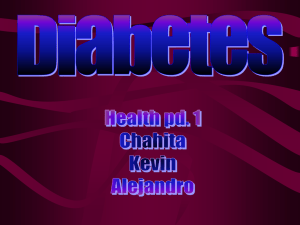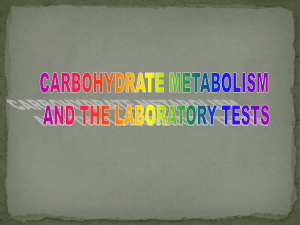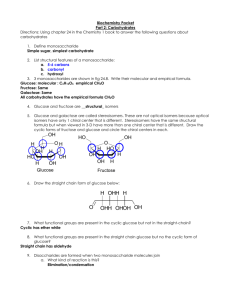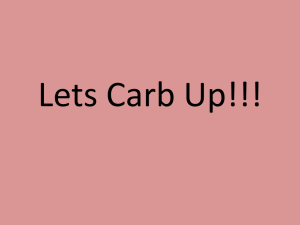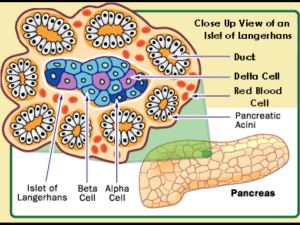Postprandial Hyperglycaemia in Type2 Diabetes i h
advertisement
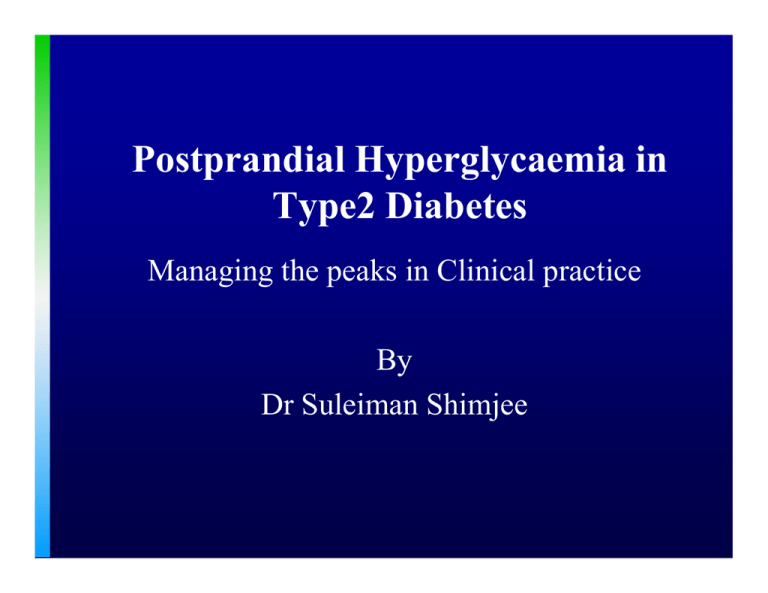
Postprandial Hyperglycaemia in Type2 Diabetes Managing i the h peaks k in i Clinical li i l practice i By Dr Suleiman Shimjee Overview • Pathophysiology of Type2 Diabetes, role of PPH. Why y is it relevant? • Importance of managing postprandial hyperglycaemia The Evidences. hyperglycaemia. Evidences • Clinical management of postprandial hyperglycaemia – the therapeutic agents Etiology of type 2 diabetes Genes + environmental factors Insulin resistance at the beginning Normal ß-cell function later Abnormal (decreased) ß-cell function Compensatory hyperinsulinemia Relative insulin deficiency Fasting euglycemia Hyperglycemia Type 2 diabetes Patients With Type 2 Diabetes May Spend More Than 12 Hours per Day in the Postprandial State Postprandial Postabsorptive Fasting Duration of postprandial state Breakfast 8 AM Lunch 11 AM 2 PM Dinner 5 PM Adapted from Monnier L. Eur J Clin Invest. 2000;30(suppl 2):3-11. Midnight 4 AM Breakfast Pattern of insulin secretion is altered early y in type yp 2 diabetes Loss of first phase insulin secretion 120 100 Type 2 diabetic Plasma IRI (µU/m ml) Plasma IRI (µU/m ml) Normal 20 g glucose 80 60 40 120 100 80 60 40 20 20 0 0 –30 0 30 60 90 120 Time (minutes) Ward WK, et al. Diabetes Care 1984;7:491–502. 20 g gl glucose cose –30 0 30 60 90 120 Time (minutes) Earliest abnormality of type 2 diabetes: postprandial p p hyperglycemia yp g y 300 T Type 2 diabetes di b t Gluco ose (mg/dl) 250 200 150 IGT 100 Normal Time of day 50 8 9 10 11 12 1 2 3 Adapted from: Reaven GM, et al. J Clin Endocrinol Metab 1993; 76: 44–48. 4 Postprandial glucose in normal, IGT and diabetic subjects Diabetes Plasm ma glucose e (mg/dl) 220 200 11.1 mmol/l 180 160 140 7.8 mmol/l IGT 120 Normoglycemia 100 0 1 2 3 Time following meal (hours) Harris MI Diabetes Care 1993; 16 16:: 642 642--52 Early diabetes is a postprandial disease Role of PPG in the progression of Type2 diabetes • PPG rise before fasting • High PPG -> down regulate insulin receptors -> increase insulin resistance (Bell 2001) • Glucotoxicity -> accelerated loss if βcell (Miedler al 2002) • Lipotoxicity -> obesity -> raised fatty acid -> ↑PPG PPG contribution to HBA1C • HBA1C - fastingg and ppost-prandial p hyperglycaemia yp g y • DCCT -> ↑HBA1C -> ↑complications • Early disease -> normal fasting glucose but raised HBA1C • Post P t lunch l h glucose l related l t d to t HBA1C (1997 Avignon) Ai ) • Contribution of PPG to overall control • HBA1C < 7.3% -> PPG 69.&% •HBA1C > 10.2% -> PPG 30.5% (Monnier et al 2003) In Individuals with HbA1C <6.5%, Postload Dysglycemia Predominates Woerle HJ et al Arch Intern Med. 2004;164:1627-1632. As Patients Get Closer to A1C Goal, the Need to Successfully Manage PPG Significantly Increases Increasing g Contribution of PPG as A1C Improves % C Contributio on 100% 30% 80% 60% 70% 60% 55% 50% 40% 20% 70% 30% 40% 45% 50% 0% < 10.2 10 2 10 2 tto 9 10.2 9.3 3 9.2 9 2 tto 8 8.5 5 8.4 8 4 tto 7 7.3 3 A1C Range (%) Adapted from Monnier L, L Lapinski H, H Collette C. C Contributions of fasting and postprandial plasnma glucose increments to the overall diurnal hyper glycemia of Type 2 diabetic patients: variations with increasing levels of HBA(1c). Diabetes Care. 2003;26:881-885. < 7.3 73 FPG PPG PPG, but not FPG distinguishes patients with HbA1C Between 6.0-7.0% 6 0-7 0% HbA1C Group (%) • Characteristics – – – – – – – # of patients Gender Age BMI FPG 2hPPG Mean HbA1C • 6.0-6.5 – – – – – – – 37 14/23 54.6 27.8 111 198 6.26 Woerle HJ et al Arch Intern Med. 2004;164:1627-1632. 6.6-7.0 16 8/8 49.6 27.9 113 (p=0.88) 226 (p=0.03) 6.73 Effect of pre- vs. postprandial glucose monitoring on HbA1c in gestational diabetes 12 14 HbA A1c (%) HbA A1c (%) 14 Preprandial monitoring (n = 33) 10 12 10 8 8 6 6 Initial Final Perccentage cha ange in HbA1c 1 0 –1 1 –2 –3 –4 –5 –6 De Veciana et al. New Engl J Med 1995; 333; 1230 Postprandial monitoring (n = 33) Initial Final Macro- and microvascular complications Cerebrovascular circulation Coronary arteries Renal arteries Stroke (22%*) Retinopathy Angina MI (34.7%*) Sudden death Renal damage Peripheral vascular disease Peripheral P i h l arteries Gangrene and amputation (2.7%) *Causes of death in diabetic population Is postmeal hyperglycaemia harmful? • Epidemological studies → strong association between post-meal glycaemia & cardiovascular risks and outcomes • Growing evidence → relationship between PPH and: – Oxidative stress – Corotid IMT – Endothelial E d th li l dysfunction d f ti Which are all markers of CVD • PPH → • Retinopathy • Cognitive dysfunction in elderly people • Certain cancers DECODE & DECODA Study • Diabetes Epidemiology p gy Collaborative Analysis y of Diagnostic g Criteria in Europe (DECODE) and in Asia (DECODA) • 25000 people with newly diagnosed type 2 diabetes • 2000 deaths • Mean follow up 7.3 years • Suggested the 2 hour post prandial blood glucose was associated with increased mortality • 2 hour plasma glucose better predictor of cardiovascular and all cause mortality than fasting glucose • European – 6.6% with IGT developed DM • Asian - 18.9 %with IGT developed DM Relative risk for death increases with 2hour blood gglucose irrespective p of the FPG level 2.5 Hazarrd ratio 20 2.0 1.5 1.0 ≥11.1 0.5 7.8–11.0 <7.8 0.0 <6.1 6.1–6.9 ≥7.0 Fasting g plasma p glucose g (mmol/l) ( ) Adjusted for age, center, sex DECODE Study Group. Lancet 1999;354:617–621 Development of type 2 diabetes FPG 6.1 6 1 - 7.0mmol/L 7 0mmol/L 2h ppBG 7.8 - 11.1 mmol/L Impaired glucose tolerance (IGT) Insulin sensitivity Insulin secretion FPG >7.0mmol/L >7 0mmol/L 2h ppBG >11.1 mmol/L Hyperglycemia Level of blood glucose MicroMicro vascular complications MacroMacro vascular complications RETINOPATHY & PPH • Limited evidence PPH and microvascular disease • JAPAN Study (Biochem Biophys Res Commun 2005; 336(1):339-345) 336(1):339 345) • PPH better that HBA1C RISK OF PANCREATIC CANCER • Large prospective cohort study- PPH an increase risk of p pancreatic cancer (JAMA ( 2000) • Association is stronger in man Impaired Cognitive Dysfunction • PPH associated with impaired cognitive function in elderly patient with Type2 Diabetes (Abb t l AM, (Abbatecola AM Rizzo, Ri Neurology N l 2006) A Agents targeting i PPG • Glinides • Alpha-Glucosidase Alpha Glucosidase inhibitors • Incretins • Insulin – Rapid-acting analogues Glitinides e.g. Novonorm, Prandin • Stimulate insulin secretion in the presence of glucose g • Reduces peak postprandial glucose and HBA1C • Other effects: - hypoglycaemia - weight i h gain i - no effects on lipids Alpha Glucosidase Inhibitors e.g. Acorbose • Block enzymes that digest starch in the small intestine • Decreases peak postpandrial glucose (2.2-2.8 mmol/l) D Decreases A1C bby 00.5-1% 5 1% • Other effects -> flatulence & abdominal discomfort -> no effects on Bpp and lipids p -> no weight gain -> C/I in IBD and cirrhosis • STOP-NIDDM S O -> reduces d risk i k off MI andd hypertension h i I Incretins ti The new Darling in the treatment of Type2 Diabetes • GLP1 analogue, liraglitide, Exenatide, Exenatide LAR • DPP4 inhibitors : Sitagliptin Vildagliptin g p Incretin & Glucose Metabolism • Intestinal hormones stimulate post prandial secretion of insulin, e.g,: GIP (g (glucose dependant p insulin polypeptide) p yp p ) GLP1 (glucagon-like peptide 1) • Low levels of GIP & GLP1 during fasting • Raise level within minutes of eating -> specific receptors ecep o s in islet s e Bcells ce s -> sstimulates u es insulin su sec secretion e o • GIP & GLP1 rapidly degraded by enzyme dipeptidyl peptidase p p ((DPP4)) Incretin & Glucose Metabolism • Incretin response is impaired in Type2 Diabetes • Hence drugs enhancing Incretin activity: - Mimicking GLP1 - Inhibiting DPP4 • Exedin 4 – longer g half life Actions of GLP1 11. 2. 3 3. 4. Effects on 1st phase insulin secretion Slows gastric emptying S Suppresses appetite i Decrease glucagon secretion Exenatide • • • • GLP1 analogue g License for use with metformin and/or sulphonylurea Dosage 5mcg and 10 mcg (before meals) AMIGO studies: t di exenatide tid significantly i ifi tl reduce d HBA1C (0 (0.88 1%) in association with weight loss in patients not at goal • 2 blinded non-inferiority studies Exenatide v/s Glargine Exenatide v/s Bi-phasic insulin B th studies Both t di showed h d non-inferiority i f i it to t insulin i li (HBA1C↓ 0.909 1.1%) Weight reduction 4.1kg (in Glargine 5.4kg in bi-phasic insulin) Exenatide • Unwanted effect of nausea and vomiting • Mild hypo h glycaemia l i • Reports of acute pancreatitis with exenatide -> FDA WARNING Exenatide LAR • Phase 3 clinical trial 50% had A1C < 6.5% 6 5% and 75% had A1C < 7.0% • LANCET -> > non inferiority i f i it study t d showed h d showed greater reduction in A1C and fewer side effects LIRAGLUTIDE • • • • Long acting GLP1 analogue Derivative of human GLP1 (97% homology) Once daily preparation: 0.6mg, 1.2mg, 1.8mg (LEAD IV) – lower l TG & systolic li blood bl d pressure, more weight loss • Care! Medullary Ca of thyroid in animal subject DPP4 inhibitors • Sitagliptin – license in dual or triple therapy • 100mg once daily dose • Meta analysis: l i as monotherapy h reduce d HBA1C A1C (0.77% v/s placebo) • Less effective as monotherapy v/s other oral agents • Weight neutral DPP4 inhibitors • Vildagliptin – dose 50mg bd with metformin - dose 50mg od with sulphonylurea • Further reduction in A1C Role of GLP1 i the in h life lif andd death d h off pancreatic i cells ll • Stimulates insulin secretion • Induces replication of islet cells • Promotes islet cells neogenesis of pancreatic ductal cells • Inhibits apoptosis Case Presentations Case 1 • Mrs X: – – – – 53 yrs old. Type 2 DM 17yrs BMI 31 kg/m g 2 Lifestyle OK, sees dietician Medication: Lantus • • • • 90 units bedtime Pioglitazone 30mg OD M df Medformin i 1g 1 BD Glimepiride 6mg OD • • • • HBA1C 88.5% 5% Fasting glucose 6.5 mmol/l Premeal glucose 9-13 mmol/l Postmeal glucose greater than 16mmol/l WHAT WOULD YOU DO NEXT ? • Started on Basal bolus regime • Dose D tit titration ti • 60 units lantus, 20-25 units of postprandial insulin 3 Months later • HBA1C 7.2% • No increase in weight Clinical Pearls • A pattern of rising blood glucose during the day, with partial or complete correction overnight, suggests insufficient prandial insulin effect. • Basal bolus regime allows greater freedom for patients to eat as they would like while making ki hhealthy lth food f d choices. h i • This was also clearly a case of β-cells f il failure Case #2 • 45 yr old man with Type2 Diabetes • Referred with 6 weeks history of osmotic symptoms • Was started on metformin 500mg bd by GP, GP 3 months ago, HBA1C 9.4%, BMI=32.4 • Now N HBA1C 88.4% 4% bbut now BMI BMI=31.8 31 8 • Has made big efforts re diet & exercise What is the most appropriate treatment? 1. 2 2. 3. 4 4. 5. 6. Insulin Pioglitazone Increase metformin Add sulphonyrea l h GLP1 DDP4 inhibitors CONCLUSION • Earliest E li t abnormality b lit off Type2 T 2 diabetes di b t is i postpandial t di l hyperglycaemia • Good evidence to support beneficial effect of targeting PPG excursions • Emerging therapies -> aiming at PPG -> will benefit people with Type2 Diabetes THANK YOU !!!
